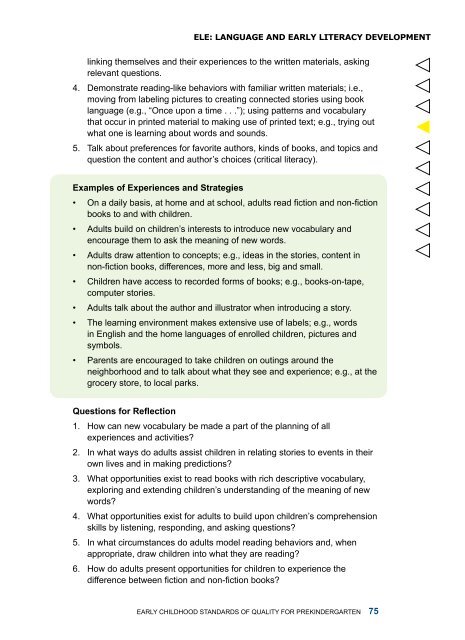Early Childhood Standards of Quality for ... - State of Michigan
Early Childhood Standards of Quality for ... - State of Michigan
Early Childhood Standards of Quality for ... - State of Michigan
You also want an ePaper? Increase the reach of your titles
YUMPU automatically turns print PDFs into web optimized ePapers that Google loves.
ELE: Language and <strong>Early</strong> Literacy Developmentlinking themselves and their experiences to the written materials, askingrelevant questions.4. Demonstrate reading-like behaviors with familiar written materials; i.e.,moving from labeling pictures to creating connected stories using booklanguage (e.g., “Once upon a time . . .”); using patterns and vocabularythat occur in printed material to making use <strong>of</strong> printed text; e.g., trying outwhat one is learning about words and sounds.5. Talk about preferences <strong>for</strong> favorite authors, kinds <strong>of</strong> books, and topics andquestion the content and author’s choices (critical literacy).Examples <strong>of</strong> Experiences and Strategies• On a daily basis, at home and at school, adults read fiction and non-fictionbooks to and with children.• Adults build on children’s interests to introduce new vocabulary andencourage them to ask the meaning <strong>of</strong> new words.• Adults draw attention to concepts; e.g., ideas in the stories, content innon-fiction books, differences, more and less, big and small.• Children have access to recorded <strong>for</strong>ms <strong>of</strong> books; e.g., books-on-tape,computer stories.• Adults talk about the author and illustrator when introducing a story.• The learning environment makes extensive use <strong>of</strong> labels; e.g., wordsin English and the home languages <strong>of</strong> enrolled children, pictures andsymbols.• Parents are encouraged to take children on outings around theneighborhood and to talk about what they see and experience; e.g., at thegrocery store, to local parks.Questions <strong>for</strong> Reflection1. How can new vocabulary be made a part <strong>of</strong> the planning <strong>of</strong> allexperiences and activities?2. In what ways do adults assist children in relating stories to events in theirown lives and in making predictions?3. What opportunities exist to read books with rich descriptive vocabulary,exploring and extending children’s understanding <strong>of</strong> the meaning <strong>of</strong> newwords?4. What opportunities exist <strong>for</strong> adults to build upon children’s comprehensionskills by listening, responding, and asking questions?5. In what circumstances do adults model reading behaviors and, whenappropriate, draw children into what they are reading?6. How do adults present opportunities <strong>for</strong> children to experience thedifference between fiction and non-fiction books?<strong>Early</strong> <strong>Childhood</strong> <strong>Standards</strong> <strong>of</strong> <strong>Quality</strong> <strong>for</strong> Prekindergarten 75


